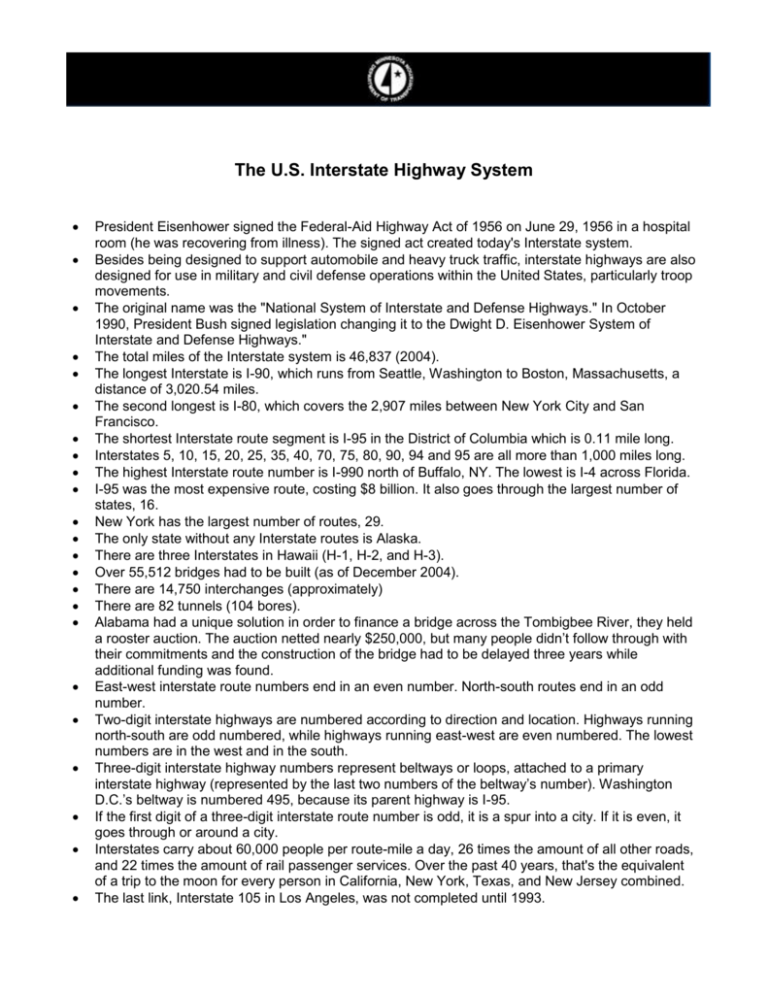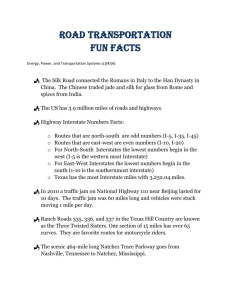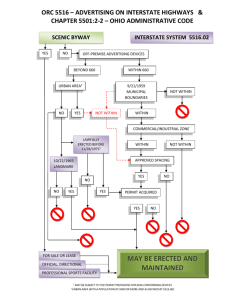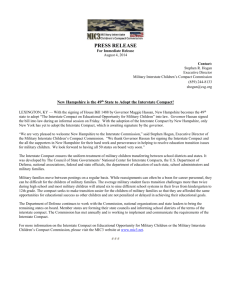National Facts - Minnesota Department of Transportation
advertisement

The U.S. Interstate Highway System President Eisenhower signed the Federal-Aid Highway Act of 1956 on June 29, 1956 in a hospital room (he was recovering from illness). The signed act created today's Interstate system. Besides being designed to support automobile and heavy truck traffic, interstate highways are also designed for use in military and civil defense operations within the United States, particularly troop movements. The original name was the "National System of Interstate and Defense Highways." In October 1990, President Bush signed legislation changing it to the Dwight D. Eisenhower System of Interstate and Defense Highways." The total miles of the Interstate system is 46,837 (2004). The longest Interstate is I-90, which runs from Seattle, Washington to Boston, Massachusetts, a distance of 3,020.54 miles. The second longest is I-80, which covers the 2,907 miles between New York City and San Francisco. The shortest Interstate route segment is I-95 in the District of Columbia which is 0.11 mile long. Interstates 5, 10, 15, 20, 25, 35, 40, 70, 75, 80, 90, 94 and 95 are all more than 1,000 miles long. The highest Interstate route number is I-990 north of Buffalo, NY. The lowest is I-4 across Florida. I-95 was the most expensive route, costing $8 billion. It also goes through the largest number of states, 16. New York has the largest number of routes, 29. The only state without any Interstate routes is Alaska. There are three Interstates in Hawaii (H-1, H-2, and H-3). Over 55,512 bridges had to be built (as of December 2004). There are 14,750 interchanges (approximately) There are 82 tunnels (104 bores). Alabama had a unique solution in order to finance a bridge across the Tombigbee River, they held a rooster auction. The auction netted nearly $250,000, but many people didn’t follow through with their commitments and the construction of the bridge had to be delayed three years while additional funding was found. East-west interstate route numbers end in an even number. North-south routes end in an odd number. Two-digit interstate highways are numbered according to direction and location. Highways running north-south are odd numbered, while highways running east-west are even numbered. The lowest numbers are in the west and in the south. Three-digit interstate highway numbers represent beltways or loops, attached to a primary interstate highway (represented by the last two numbers of the beltway’s number). Washington D.C.’s beltway is numbered 495, because its parent highway is I-95. If the first digit of a three-digit interstate route number is odd, it is a spur into a city. If it is even, it goes through or around a city. Interstates carry about 60,000 people per route-mile a day, 26 times the amount of all other roads, and 22 times the amount of rail passenger services. Over the past 40 years, that's the equivalent of a trip to the moon for every person in California, New York, Texas, and New Jersey combined. The last link, Interstate 105 in Los Angeles, was not completed until 1993. The interstate sign itself measures 36 inches high, and is 36 inches wide for two-digit interstates, or 45 inches for three digit interstates. The original projected cost of the interstate system was $37.62 billion in 1958. That number increased to $128.90 billion in 1991. The initial cost estimate for the interstate system was $25 billion over 12 years; it ended up costing $114 billion, taking 35 years to complete. As of 2004, the system contains over 42,700 miles of roads, all at least four lanes wide. In Vinita, Oklahoma, a McDonald’s restaurant is built over the top of Interstate 44. It goes from one side of the interstate to the other, passing over the interstate. Customers can sit inside and eat while traffic drives beneath them. In Kearney, Nebraska, the GreatPlatteRiverRoadArchwayMuseum is built over the top of Interstate 80. The 1,500-ton structure spans 308 feet across the interstate and houses a museum dedicated to frontier culture. In Reno, Nevada, a Walgreen’s store is on top of a segment of Interstate I-80 in downtown Reno. In Newton, Massachusetts, a Star Market supermarket is built over the top of Interstate 90. Traffic reporters refer to this point on the highway as the “Star Market overpass”. In Newton, Massachusetts, a Sheraton hotel is built over the top of Interstate 90. In Boston, Massachusetts, the Prudential Tower in downtown Boston is built over the top of Interstate 90. The Eisenhower Memorial Tunnel (Interstate 70), Clear Creek/Summit counties in Colorado, is 11,012 feet (east) and 11,158 (west) above sea level. The highest interstate elevation. The lowest elevation is Interstate 8, El Centro, CA, 52 feet below sea level. Interstate 8 near Le Centro, California, is approximately 47 feet below sea level (exact lowest point is not officially measured). The interstate connects 45 of the 50 state capitals, including the nation’s capital, Washington, D.C. The five state capitals not directly served by the interstate systems are Juneau, AK; Dover, DE; Jefferson City, MO; Carson City, NV; and Pierre, SD. In 1972, there was a count of 1,214 rest areas along the interstate system. An exact count of rest areas hasn’t been available since then, but the current number is not expected to differ significantly from the 1972 figure. Interstates make up less than 1 percent of the total U.S. highway mileage, but the interstates carry over 24% of travel, including 41% of total truck miles traveled. There are 21 “secret” interstate routes. They are federally maintained and adhere to the standards of any other signed interstate highway, but are officially part of the Eisenhower Interstate System only on paper. In modern history, France was the first Western nation to begin building a system of national highways (1716). Americans traveled 667 billion miles on the Interstates in the year 2000. There is an average of nearly three million tons of concrete in a mile of Interstate. In Minnesota, and a few other states, there was actually highway Princesses. Standards were also established for numbering the routes: Routes with odd numbers run north-south. Routes with even numbers run east-west. For north-south routes, the lowest numbers are in the west. For east-west routes, the lowest numbers are in the south. So, I-5 runs north-south along the west coast, while I-10 runs east-west in the south. To avoid duplication within a state, prefixes are used for the three-digit numbers. For example, I-80 runs through three cities in a state, so the routes in those cities would be numbered I-280, I-480 and I680. For spur routes into three cities, the routes would be numbered I-180, I-380 and I-580. This system is not carried across state lines. As a result, two cities in different states along I-80 may each have circumferential beltways numbered I-280 or spur routes numbered I-180. There is also a system for numbering interstate interchanges, also known as exits. States do this numbering and can choose between two methods: The consecutive numbering system starts at the most western or southern point on each interstate route, and interchanges are numbered consecutively (so the first one is interchange #1). The milepost system numbers the interchange according to the miles counted, starting at the most western or southern point. An interchange occurring between mileposts 4 and 5 would be designated interchange #4. A widespread, but false, urban legend states that one out of every five miles of the Interstate Highway System must be built straight and flat, so as to be usable by aircraft during times of war. However, it was the Germans in World War II that used the Autobahns for just such a purpose. The construction of Interstates accounted for 82% of the total cost. Other costs included rightof-way acquisition and preliminary engineering. Compiled from the following Web sites: ARTBA (American Road & Transportation Builders Association) Iowa Department of Transportation Wikipedia AASHTO







